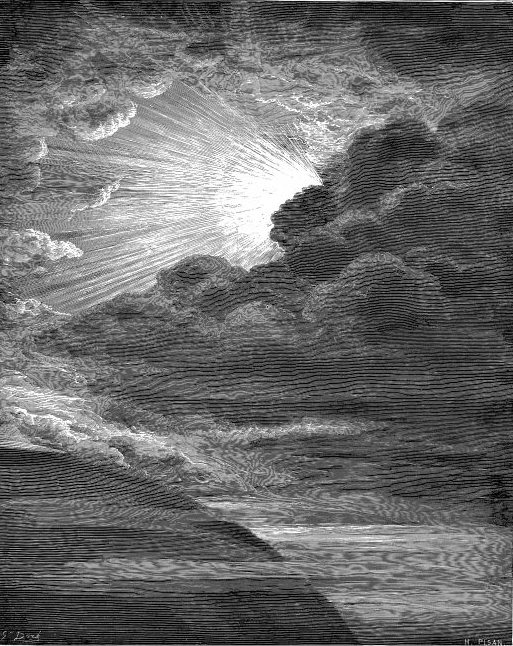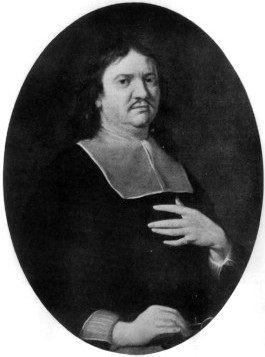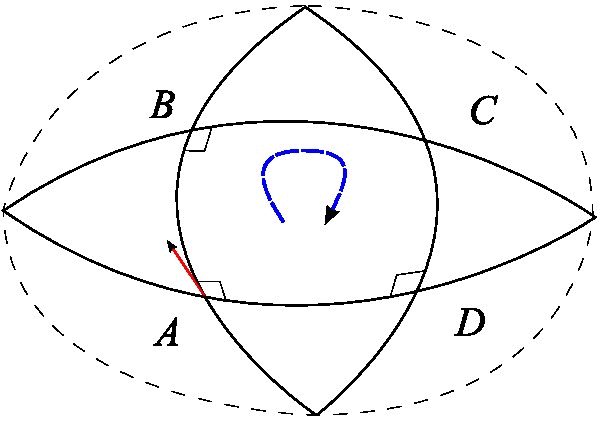|
Dark Star (Newtonian Mechanics)
A dark star is a theoretical object compatible with Newtonian mechanics that, due to its large mass, has a surface escape velocity that equals or exceeds the speed of light. Whether light is affected by gravity under Newtonian mechanics is unclear but if it were accelerated the same way as projectiles, any light emitted at the surface of a dark star would be trapped by the star's gravity, rendering it dark, hence the name. Dark stars are analogous to black holes in general relativity. Dark star theory history John Michell and dark stars During 1783 geologist John Michell wrote a letter to Henry Cavendish outlining the expected properties of dark stars, published by The Royal Society in their 1784 volume. Michell calculated that when the escape velocity at the surface of a star was equal to or greater than lightspeed, the generated light would be gravitationally trapped so that the star would not be visible to a distant astronomer. Michell's idea for calculating the number of s ... [...More Info...] [...Related Items...] OR: [Wikipedia] [Google] [Baidu] |
Newtonian Mechanics
Newton's laws of motion are three basic Scientific law, laws of classical mechanics that describe the relationship between the motion of an object and the forces acting on it. These laws can be paraphrased as follows: # A body remains at rest, or in motion at a constant speed in a straight line, unless acted upon by a force. # When a body is acted upon by a force, the time rate of change of its momentum equals the force. # If two bodies exert forces on each other, these forces have the same magnitude but opposite directions. The three laws of motion were first stated by Isaac Newton in his ''Philosophiæ Naturalis Principia Mathematica'' (''Mathematical Principles of Natural Philosophy''), originally published in 1687. Newton used them to investigate and explain the motion of many physical objects and systems, which laid the foundation for classical mechanics. In the time since Newton, the conceptual content of classical physics has been reformulated in alternative ways, inv ... [...More Info...] [...Related Items...] OR: [Wikipedia] [Google] [Baidu] |
Corpuscular Theory Of Light
In optics, the corpuscular theory of light states that light is made up of small discrete particles called " corpuscles" (little particles) which travel in a straight line with a finite velocity and possess impetus. This was based on an alternate description of atomism of the time period. Isaac Newton laid the foundations for this theory through his work in optics. This early conception of the particle theory of light was an early forerunner to the modern understanding of the photon. This theory came to dominate the conceptions of light in the eighteenth century, displacing the previously prominent vibration theories, where light was viewed as 'pressure' of the medium between the source and the receiver, first championed by René Descartes, and later in a more refined form by Christiaan Huygens. It would fall out of the spotlight in the early nineteenth century, as the wave theory of light amassed new experimental evidence. Mechanical philosophy In the early 17th century, natu ... [...More Info...] [...Related Items...] OR: [Wikipedia] [Google] [Baidu] |
Dark Concepts In Astrophysics
Darkness, the direct opposite of lightness, is defined as a lack of illumination, an absence of visible light, or a surface that absorbs light, such as black or brown. Human vision is unable to distinguish colors in conditions of very low luminance. This is because the hue sensitive photoreceptor cells on the retina are inactive when light levels are insufficient, in the range of visual perception referred to as scotopic vision. The emotional response to darkness has generated metaphorical usages of the term in many cultures, often used to describe an unhappy or foreboding feeling. Referring to a time of day, complete darkness occurs when the Sun is more than 18° below the horizon, without the effects of twilight on the night sky. Scientific Perception The perception of darkness differs from the mere absence of light due to the effects of after images on perception. In perceiving, the eye is active, and the part of the retina that is unstimulated produces a com ... [...More Info...] [...Related Items...] OR: [Wikipedia] [Google] [Baidu] |
Philosophical Transactions Of The Royal Society Of London
''Philosophical Transactions of the Royal Society'' is a scientific journal published by the Royal Society. In its earliest days, it was a private venture of the Royal Society's secretary. It was established in 1665, making it the first journal in the world exclusively devoted to science, and therefore also the world's longest-running scientific journal. It became an official society publication in 1752. The use of the word ''philosophical'' in the title refers to natural philosophy, which was the equivalent of what would now be generally called ''science''. Current publication In 1887 the journal expanded and divided into two separate publications, one serving the physical sciences ('' Philosophical Transactions of the Royal Society A: Mathematical, Physical and Engineering Sciences'') and the other focusing on the life sciences ('' Philosophical Transactions of the Royal Society B: Biological Sciences''). Both journals now publish themed issues and issues resulting from ... [...More Info...] [...Related Items...] OR: [Wikipedia] [Google] [Baidu] |
Q Star
A Q-star, also known as a grey hole, is a hypothetical type of a compact, heavy neutron star with an exotic state of matter. Such a star can be smaller than the progenitor star's Schwarzschild radius and have a gravitational pull so strong that some light, but not all light, cannot escape. The Q stands for a conserved particle number. A Q-Star may be mistaken for a stellar black hole. Types of Q-stars *SUSY Q-ball *B-ball, stable Q-balls with a large baryon number B. They may exist in neutron stars that have absorbed Q-ball(s). See also *Black hole **Stellar black hole *Compact star ** Exotic star *** Boson star *** Electroweak star *** Preon star ***Strange star ***Quark star A quark star is a hypothetical type of compact, exotic star, where extremely high core temperature and pressure has forced nuclear particles to form quark matter, a continuous state of matter consisting of free quarks. Background Some massiv ... References Further reading * * Degenerate s ... [...More Info...] [...Related Items...] OR: [Wikipedia] [Google] [Baidu] |
Magnetospheric Eternally Collapsing Object
The magnetospheric eternally collapsing object (MECO) is an alternative model for black holes initially proposed by Indian scientist Abhas Mitra in 1998 and later generalized by American researchers Darryl J. Leiter and Stanley L. Robertson. A proposed observable difference between MECOs and black holes is that a MECO can produce its own intrinsic magnetic field. An uncharged black hole cannot produce its own magnetic field, though its accretion disc can. Theoretical model In the theoretical model a MECO begins to form in much the same way as a black hole, with a large amount of matter collapsing inward toward a single point. However, as it becomes smaller and denser, a MECO does not form an event horizon. As the matter becomes denser and hotter, it glows more brightly. Eventually its interior approaches the Eddington limit. At this point the internal radiation pressure is sufficient to slow the inward collapse almost to a standstill. In fact, the collapse gets slower and slow ... [...More Info...] [...Related Items...] OR: [Wikipedia] [Google] [Baidu] |
Black Hole
A black hole is a region of spacetime where gravity is so strong that nothing, including light or other electromagnetic waves, has enough energy to escape it. The theory of general relativity predicts that a sufficiently compact mass can deform spacetime to form a black hole. The boundary of no escape is called the event horizon. Although it has a great effect on the fate and circumstances of an object crossing it, it has no locally detectable features according to general relativity. In many ways, a black hole acts like an ideal black body, as it reflects no light. Moreover, quantum field theory in curved spacetime predicts that event horizons emit Hawking radiation, with the same spectrum as a black body of a temperature inversely proportional to its mass. This temperature is of the order of billionths of a kelvin for stellar black holes, making it essentially impossible to observe directly. Objects whose gravitational fields are too strong for light to escape were fi ... [...More Info...] [...Related Items...] OR: [Wikipedia] [Google] [Baidu] |
Riemann Curvature Tensor
In the mathematical field of differential geometry, the Riemann curvature tensor or Riemann–Christoffel tensor (after Bernhard Riemann and Elwin Bruno Christoffel) is the most common way used to express the curvature of Riemannian manifolds. It assigns a tensor to each point of a Riemannian manifold (i.e., it is a tensor field). It is a local invariant of Riemannian metrics which measures the failure of the second covariant derivatives to commute. A Riemannian manifold has zero curvature if and only if it is ''flat'', i.e. locally isometric to the Euclidean space. The curvature tensor can also be defined for any pseudo-Riemannian manifold, or indeed any manifold equipped with an affine connection. It is a central mathematical tool in the theory of general relativity, the modern theory of gravity, and the curvature of spacetime is in principle observable via the geodesic deviation equation. The curvature tensor represents the tidal force experienced by a rigid body movin ... [...More Info...] [...Related Items...] OR: [Wikipedia] [Google] [Baidu] |
Black Hole Information Paradox
The black hole information paradox is a puzzle that appears when the predictions of quantum mechanics and general relativity are combined. The theory of general relativity predicts the existence of black holes that are regions of spacetime from which nothing — not even light — can escape. In the 1970s, Stephen Hawking applied the rules of quantum mechanics to such systems and found that an isolated black hole would emit a form of radiation called Hawking radiation. Hawking also argued that the detailed form of the radiation would be independent of the initial state of the black hole and would depend only on its mass, electric charge and angular momentum. The information paradox appears when one considers a process in which a black hole is formed through a physical process and then evaporates away entirely through Hawking radiation. Hawking's calculation suggests that the final state of radiation would retain information only about the total mass, electric charge and angular ... [...More Info...] [...Related Items...] OR: [Wikipedia] [Google] [Baidu] |
No-hair Theorem
The no-hair theorem states that all stationary black hole solutions of the Einstein–Maxwell equations of gravitation and electromagnetism in general relativity can be completely characterized by only three independent ''externally'' observable classical parameters: mass, electric charge, and angular momentum. Other characteristics (such as geometry and magnetic moment) are uniquely determined by these three parameters, and all other information (for which "hair" is a metaphor) about the matter that formed a black hole or is falling into it "disappears" behind the black-hole event horizon and is therefore permanently inaccessible to external observers after the black hole "settles down" (by emitting gravitational and electromagnetic waves). Physicist John Archibald Wheeler expressed this idea with the phrase "black holes have no hair", which was the origin of the name. In a later interview, Wheeler said that Jacob Bekenstein coined this phrase. Richard Feynman objected ... [...More Info...] [...Related Items...] OR: [Wikipedia] [Google] [Baidu] |
Hawking Radiation
Hawking radiation is theoretical black body radiation that is theorized to be released outside a black hole's event horizon because of relativistic quantum effects. It is named after the physicist Stephen Hawking, who developed a theoretical argument for its existence in 1974. Hawking radiation is a purely kinematic effect that is generic to Lorentzian geometries containing event horizons or local apparent horizons. Hawking radiation reduces the mass and rotational energy of black holes and is therefore also theorized to cause black hole evaporation. Because of this, black holes that do not gain mass through other means are expected to shrink and ultimately vanish. For all except the smallest black holes, this would happen extremely slowly. The radiation temperature is inversely proportional to the black hole's mass, so micro black holes are predicted to be larger emitters of radiation than larger black holes and should dissipate faster. Overview Black holes are astrophys ... [...More Info...] [...Related Items...] OR: [Wikipedia] [Google] [Baidu] |
Faster Than Light
Faster-than-light (also FTL, superluminal or supercausal) travel and communication are the conjectural propagation of matter or information faster than the speed of light (). The special theory of relativity implies that only particles with zero rest mass (i.e., photons) may travel ''at'' the speed of light, and that nothing may travel faster. Particles whose speed exceeds that of light (tachyons) have been hypothesized, but their existence would violate causality and would imply time travel. The scientific consensus is that they do not exist. "Apparent" or "effective" FTL, on the other hand, depends on the hypothesis that unusually distorted regions of spacetime might permit matter to reach distant locations in less time than light could in normal ("undistorted") spacetime. As of the 21st century, according to current scientific theories, matter is required to travel at slower-than-light (also STL or subluminal) speed with respect to the locally distorted spacetime region. Appa ... [...More Info...] [...Related Items...] OR: [Wikipedia] [Google] [Baidu] |





